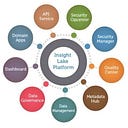Member-only story
Best Practices for Data Models in Modern Analytics Solutions Using Databricks and Cloud Databases
Introduction
In today’s data-driven landscape, enterprises demand analytics solutions that empower business users with self-serve insights, foster rapid innovation, and ensure governed data access. Cloud-native platforms like Databricks, Snowflake, and AWS Redshift have revolutionized analytics architectures by enabling scalable storage, compute separation, and AI/ML-driven data processing. However, a well-designed data model remains critical to achieving the balance between performance, flexibility, and governance.
This blog explores best practices for structuring data models in a modern analytics stack using Databricks and cloud databases, addressing key considerations such as denormalization vs. star schema, Bronze/Silver/Gold data layers, operational and self-serve analytics, and catalog-driven data access. Additionally, we compare the Bronze, Silver, and Gold layers across performance, flexibility, and cost, and include a detailed comparison of Databricks Delta Lake vs. Amazon Redshift.
Key Design Considerations for Modern Data Models
To support self-serve and operational analytics while enabling faster innovation, the data model should:
- Support Flexible Schema Evolution: Allow new fields and datasets to be onboarded quickly without requiring extensive rework.
